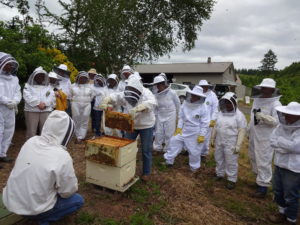Do you fly a drone? No I don’t mean the live drones you find in your bee colony or tethered drones you might fly at a bee display but instead I am asking if you fly a robotic drone to use for aerial services? Drones have been used in war, espionage, research, videography and farming. New research is demonstrating how drones can help blueberry farmers. Flying overhead, drones can spot troubled areas in a massive blueberry patch in a fraction of the time it would take on foot.
How could you use a drone with your beekeeping? They can search the 8042 acres (2 mile radius) your bees are currently visiting so you might better ID floral resources. Or maybe you could use them to find an alternative apiary site since you made so many splits (for mite and swarm control) you need another apiary site? Or maybe rent a drone for pollination?
Agriculture is one of the leading drivers of drone technology. As beekeepers, we are well aware of the importance of our bee health if we want to increase (or even obtain) a bee product harvest or use our bees in pollination – sick bees do not do as well as when they are healthy. The same applies to crops. Drones can help spot unhealthy, under fertilized, moisture stressed areas in a field.
Kim Flottum, in his June 2019 BeeCuture editorial discusses drone and other perhaps more familiar present and future technology innovations in beekeeping. Kim mentions: “Dropcopter …[reports] way more fruit using a drone than when using honey bees … .a 25-60% pollination set on cherries and almonds and significantly increasing the pollination of king blooms on applies” (King bloom provides the best apple of a blossom cluster).
May Berenbaum Buzzwords columnist in American Entomologist had a unique take on Bot-Flying. She says Walmart (yes that Walmart) has received a patent on Pollinator “drones” entitled “Methods for pollinating crops via unmanned vehicles “According to Berenbaum, Walmart wishes “control over its future food supply chain in the post-bee-apocalypse hellscape” .
Berenbaum also comments on a DARPA (Department of Defense Advanced Research Project Agency) “multi-million dollar grant” to Harvard’s Wyss Institute for “RoboBees. “The current version weight less than two grams, beats its wings 120 times per second and can perch, fly and swim but still can’t navigate around other flying objects”. Look out bee foragers, here come RoboBee, clear out of the way so it can do its job to replace you !! I wonder what type of hive houses RoboBees?
Kim discusses other technological advances besides pollinating drones that might also might eventually do a better pollination job to replace our foraging bees. Kim cites raising pollen prior to bloom and applying it to the appropriate crop by use of electrostatic charging of pollen. Research from Washington State demonstrated that use of such technology “boosted pollination results 10-100% in cherry, pear and apple orchards”. A competitor ULTRA-SET pollination technology, used in California and Washington, can “…. increase yields 30% to 50% per acre in cherries, almonds and pistachios.”
Kim, from his national viewpoint as BeeCulture editor believes currently most of the bee “industry is watching. Aware, but not participating.” We would do well to seek to watch more intently and even see about possibly adopting some of the available technology. I don’t know if, like other technology, the prices will come down with increased adoption or not – with the great honey crops some of us are getting this year (with the ½ of our fall colonies that survived) this might be the time to invest in some technology.

